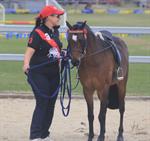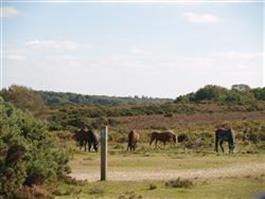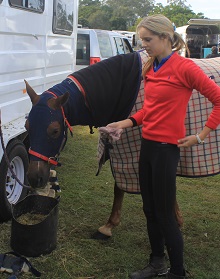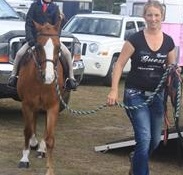Study horses around your busy life!
 Gain a solid understanding of the strong natural instincts that influence your horse's behaviour.
Gain a solid understanding of the strong natural instincts that influence your horse's behaviour.
- Identify what may be considered problem behaviour and learn how to respond.
- Learn about heritable traits, learned behaviours and social influences on your horse.
How it works: 100 hours of self-paced study. With daily intakes, you can start anytime.
Our flexible study options mean you can schedule study around your commitments and study wherever it suits you.
You're not alone though - you have access to your tutor for support from start to finish.
The exam at the end of the module is only compulsory for students working towards qualifications.
Course structure and content
This course has seven lessons:
1. Introduction: Influences and motivation
- Why study equine behaviour?
- What motivates behaviour?
- Reactive behaviour
- Active behaviour
- Cognitive behaviour
- Species behavioural differences
- Learned behaviour
- Classical conditioning
- Stimulus conditioning
- Trace conditioning
- Delayed conditioning
- Operant conditioning
- Terminology
2. Genetics and Behaviour
- Understanding the basics
- Heritability
- Epigenesis
- Innate behaviour
- Selective pressures
- Social Behaviour
- Rank
- Conflict
3. Equine Perception and Behaviour
- Imprinting
- Negative imprinting
- Sensory reception
- Mechanoreceptors
- Thermoreceptors
- Chemoreceptors
- Photoreceptors
- Stimulus filtering
4. Communication and Social Behaviour
- Social Constraints
- Herd Membership
- Auditory signals
- Chemical signals
- Communication
- Co-ordination
- Cohesion
5. Sexual and Reproductive Behaviour
- Sexual encounter
- Isolating mechanisms
- Birthing behaviour
- Foal imprinting
- Maternal behaviour
- Abnormal behaviour
6. Learning and Training
- Conditioning and learning
- Shaping
- Extinction
- Habituation
- Instrumental Learning
- Thorndike’s Law of Effect (1913)
- Operant and Respondent Behaviour
- Pseudo-conditioning
- Interoceptive conditioning.
- Temporal conditioning.
- Biological aspects of learning
- Associative learning
- Obedience
- Reinforcement
- Punishment
- Systematic desensitisation
- Counter conditioning
7. Behavioural Problems
- Types of abnormal behaviour in horses
- Diagnosing behavioural problems
- Indicators of pain
- Indicators of mild fear
- Indicators of extreme fear
- Stress
- Stereotypes
- Stable vices
- Prevention
- Ridden vices
- Handling vices
- Problems during loading
Aims
- Identify factors affecting horse behaviour.
- Describe the influence of genes on equine behaviour.
- Explain how horses perceive and how they respond to various stimuli.
- Explain how horses communicate and the nature of their social organisation.
- Explain the sexual and reproductive behaviour of the horse.
- Describe the different ways that horses learn and how this can be applied to the training environment.
- Explain how and why behavioural problems occur and how they can be prevented.
Why does a horse do that?

There are many factors that influence behaviour in horses.
Among the experts, there have been different debates over the years. One of these is the nature-nurture debate which considered the relative impact of nature (genetics) on behaviour and nurture (environment and upbringing). Some researchers argue that genetics had a greater impact on horse behaviour whereas others advocated that the environment was most influential.
Today, most animal behaviourists would argue that behaviour is a mixture of the influences of both nature and nurture - that it is more feasible to talk in terms of a behaviour having perhaps a greater or lesser genetic or environmental influence. Some of the different factors that can impact upon the development of behaviour now follow.
Genetics
Genetic information is passed on from generation to generation. We have known for some time that physical characteristics are transmitted to offspring through DNA. Matching pairs of chromosomes found in the nucleus of living cells are formed of long strings of DNA molecules. DNA contains information about how an animal should develop. A section of DNA which contains information about a specific type of development is known as a gene.
There is growing evidence that in addition to the transmission of physical characteristics, genes might also contain information which can influence the behaviour of animals and humans. For instance, a lot of research has recently been carried out into how certain genes can affect humans in terms obesity and alcoholism. Laboratory studies of animals such as rats, dogs and mice have found behavioural symptoms that resemble those of humans with these conditions.
There is still much debate about how genes affect behaviour. One of the main issues with this debate is confusion about which behaviours may have been inherited and which are most likely learned. It has also proved difficult to isolate specific genes which influence a specific behaviour fully and inevitably.
For example, although we may be able to isolate a particular gene, or a group of genes, that leads to a certain coat colour in a breed of horse, it is more difficult to say that a certain gene will result in a certain type of behaviour. That said, some behaviours may be more prevalent in particular types of breed. Some animal breeds may have a tendency towards being more aggressive, others more nervous, and others a lot more passive.
Furthermore, identifying a gene that influences a particular behaviour does not mean that the behaviour is inevitable. For example, let's say we found a gene for shyness, it would not necessarily mean that a person with the gene would automatically be shy. It would mean that in certain environmental conditions e.g. in a confrontational situation such as in a jail the gene could be “turned on” and the person could behave shyly rather than act aggressively which might be observed in the behaviour of some other prisoners. The development of any behaviour, therefore, is due to the complex interactions of factors in the environment and genetics. As the environment changes, so do a human's, or animal's, reaction to it.
Heritability
 How strong the influence of genes is on an animal’s behaviour is measured by heritability. This is the fraction of variation of a trait amongst individuals in a population. Heritability can be measured from zero to one. The smaller the variation in the population, the greater the value of the fraction will be. So, in a given population of ten dogs, if each dog has a tendency to mark their territory excessively, we would say that there is little variation in their behaviour. This would suggest that there is a greater degree of heritability underlying the behaviour. As such, if an animal breeder wishes to breed dogs that are quieter, they could choose dogs where the heritability of barking behaviour has a lower fraction value. This indicates that there is more variation in their behaviour, and the chances are improved that they will be able to breed quieter dogs.
How strong the influence of genes is on an animal’s behaviour is measured by heritability. This is the fraction of variation of a trait amongst individuals in a population. Heritability can be measured from zero to one. The smaller the variation in the population, the greater the value of the fraction will be. So, in a given population of ten dogs, if each dog has a tendency to mark their territory excessively, we would say that there is little variation in their behaviour. This would suggest that there is a greater degree of heritability underlying the behaviour. As such, if an animal breeder wishes to breed dogs that are quieter, they could choose dogs where the heritability of barking behaviour has a lower fraction value. This indicates that there is more variation in their behaviour, and the chances are improved that they will be able to breed quieter dogs.
Heritability is therefore an important consideration for breeders of animals who want to select particular characteristics they want to increase in offspring. For example, a horse breeder may want to breed faster horses. A dog breeder may want to breed more intelligent dogs, stronger dogs, or quieter dogs. A cattle breeder may wish to breed cows with a smaller ratio of fat to meat.
It is generally easier to determine the heritability of physical characteristics such as coat colour, texture, or eye colour than it is to determine behaviours, such as intelligence, which is controlled by a large number of genes. Many, many studies have looked at animals and humans and found heritability for virtually every trait ever studied, but the levels of heritability vary.
In summary, the way an animal behaves is influenced by its genetic makeup, which is a factor that cannot normally be changed. An animal cannot be trained to act in a way completely different than what its genetic blueprint dictates. To understand animal behaviour properly, it is important to understand the basics of genetics.
Why Study with ACS?
Design your own learning pathway.
Study at your own pace, from anywhere, at any time.
Receive prompt, expert support from our team of committed and friendly tutors.
Your learning is our priority. We are flexible and adaptable to meet your educational needs!
Enrolling is easy - just go to the top of this page and select your study method and payment option.
If you have any questions about studying with ACS, or want to know more about any of our courses, get in touch with our specialist tutors today.
They will be happy to answer your questions and look at different study options to fit in with your goals.